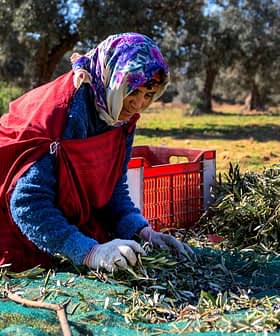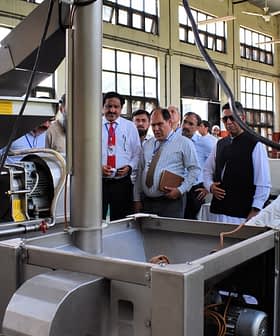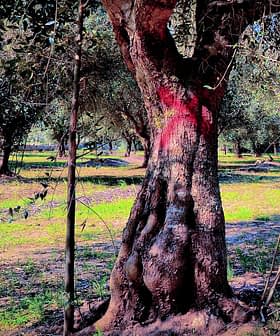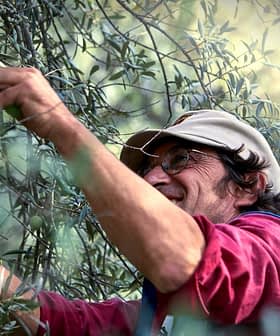Experts Offer Tips on Preparing for the Warm Season in Organic Olive Groves
The warm season corresponds to crucial phases for olive trees. Two experts provided their suggestions for the successful management of the organic olive grove in these conditions.
 Riccardo Macari prunes an olive tree.
Riccardo Macari prunes an olive tree.On a sunny July day, we reach the area of the Roman Castles where pruner Riccardo Macari is managing an organic olive grove. Today, cooler air provides relief from a heat-wave that has affected Italy for the past couple of weeks.
“This warm period followed the lower than average temperatures of April and May, which had partly eradicated some parasites, such as the olive moth (Prays oleae), which still represents a threat in some areas,” Macari said. “Now, several growers may have problems with Peacock spot and Anthracnose [caused by the fungi Spilocaea oleaginea and Colletotrichum gloeosporioides, respectively], which during last winter, which was rainy with mild temperatures, found favorable conditions for development.”
The pruner considered that those who did not act in time, for example with copper-based fungicides, may experience significant defoliation due to the Peacock’s spot, which is able to move from the old leaves to the new ones.
In some areas, we are still suffering last year’s frost damage, since the fructification mainly occurs on the branches of the previous year.
“Already in February, it was possible to predict that humidity, given by short rains with higher than average temperatures, would have triggered these diseases,” he said, adding that he treated different olive groves with copper-based products containing hydroxide, oxychloride, and above all glycinate or chelates, which minimized defoliation.
After harvesting, in some areas, he immediately started pruning. “In olive groves where I had to remove just up to 10 percent of the foliage on trees with small diameters canopies, I started pruning soon,” he said. “While for heavy trimming, as in the case of reform pruning which requires work on the main structure of the plant, I waited until the cold and frosts were over, in March.”
However, in late spring of last year, an extraordinary cold snap hit Italy and other European countries, then it became clear that we need to evaluate the situation properly to get ahead of the increasingly frequent extreme weather events.
See Also:Organic Olive Oil“Frost damages can occur if the pruning wounds are still open when it freezes,” Macari said. “The frost penetrates, breaking the vessels and causing desiccation of the branch or the whole plant. In some areas, we are still suffering last year’s frost damage, since the fructification mainly occurs on the branches of the previous year. However, even in summer we should take a break from pruning, except for young plants under four years.”
In this area, in mid-April, the first ‘mignole’ (in Italian), the inflorescences of the olive trees, popped up. During that period, which is crucial, abundant rains could be harmful as they dilute the pollen, compromising the pollination and therefore the fruit setting, Macari noted.
As long as the flowers were closed, farmers could apply Boron-based products and bio-stimulants, containing proteins, amino acids and other substances, to increase the pollen tube. However, Macari suggests acting well before or after the fruit setting.
“Immediately after that phase, we can keep the olive moth under control with appropriate treatments,” he said.
During flowering, a sudden increase of temperatures from 9 degrees Celsius (48.2 degrees Fahrenheit) to 27 degrees Celsius (80.6 degrees Fahrenheit) in the area, along with hot winds in other regions, created problems for the fruit setting. However, a good amount of fruit is now growing, and in mid-July a foliar fertilization can be done to harden the pit.
“Then, if it will rain or the temperatures drop, we must immediately monitor the presence of the olive fruit fly (Bactrocera Oleae) and other pests,” Macari said. “The olive moth has three generation per year, and with appropriate treatments, we shall act on the third generation.”
Angelo Bo, a Tuscany-based agronomist specialized in organic olive farming, gave us other reflections on the vegetative development of the olive tree and the steps to be taken in these months.
“The flowering is a delicate phase that includes the formation of the pollen tube,” he said. “Then, the pollination is followed by the fruit setting and formation. First, we should check the number of flowers, then a second production control should be made on fruits,” adding that “only two to four percent of the flowers succeed in becoming olives.”
Bo remarked that high temperatures of up to 38 degrees Celsius (100.4 degrees Fahrenheit) create problems in fruit setting, especially where the development of inflorescences has delayed. “However, in some regions, where the flowering phase started early, May was unfavorable due to low temperatures,” he pointed out.

“Now, with the young fruits on our trees, we must be careful and plan monitoring operations,” he added, explaining that traps for the olive fruit fly should be set up and, depending on the ecosystem, fertilization, nutritional supplementation, and bio-stimulation as well as monitoring of and defense from pests should also all be planned.
“In literature, if the percentage of fruits attacked by the olive moth exceed the threshold of 15 to 20 percent, based on environmental conditions, then we can apply an ovicidal or larvicidal product,” Bo said, specifying that a possible fruit falling in the second half of July will be due only to a very small extent to this pest, mainly to other factors, such as nutritional imbalances, over-loading, or re-balancing of the plant.
“This year, the Sant’Anna School of Advanced Studies of Pisa suggested that Tuscan farmers act beforehand and set up the traps against the Bactrocera Oleae between the end of June and the first days of July,” he said. “In inland areas, this action can be delayed, however, in organic farming, a key factor is to detect in time the start of the flights, and then use repellents or adulticides to prevent the egg laying.”
Monitoring of the olive fruit fly can be made with chromotropic traps, which are adhesive sheets whose yellow color attracts all the Diptera, both male and female, and the pheromone traps, which contain the substance that females use to attract the males.
“In my opinion, the combination of the two types of traps, in number of two or three per hectare (four or seven per acre) is the best solution to both detect the peak of flights and capture the females for the purpose of verifying their fertility,” Bo added.
As soon as the first flights are detected, the strategy, which may lay down repellents, baits or mass traps, should be immediately proceeded with.
“The latter perform well on plots of at least five to 10 hectares (12.3 to 24.7 acres), while on small surfaces, we have better result with repellents and insecticides,” Bo said, adding that it is important to be attentive to the strategies used by neighboring groves.
“If for example we use mass traps, but surrounding olive groves are treated with repellents, there is the risk of attracting the flies,” he observed.
Useful repellents are copper, which has both a caustic and bacteriostatic effect, acting against the bacteria laid by the flies with the eggs; kaolin-based products, which alleviate the negative effects of high temperatures; and lime-based products with tackifiers that give stability in case of rain.
On the other hand, insecticides based on compounds of the bacterial species, Saccharopolyspora spinose, which act as adulticides can also be used. Lastly, if mass traps are used, they should be set up with a density of 150 per hectare (220 per acre). They can be ready-made or easily handcrafted with a bottle containing water and substances such as ammonia, vinegar or bicarbonate, along with raw scraps of anchovies or sardines.
“We should remember that two years ago, the prolonged heat completely blocked the development of this pest in Tuscany as well as in many other regions,” Bo said. “Now, depending on the area and temperatures, we must really pay attention to the fly and to the vegetative-productive balance of our olive trees.”
“We must be ready to implement emergency irrigation or apply bio-stimulants to limit the water stress in case of drought,” he added









